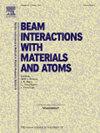Si对Fe-Mn-Ni-Si五元体系中mnsp析出的影响:相场模拟
IF 1.4
3区 物理与天体物理
Q3 INSTRUMENTS & INSTRUMENTATION
Nuclear Instruments & Methods in Physics Research Section B-beam Interactions With Materials and Atoms
Pub Date : 2025-06-02
DOI:10.1016/j.nimb.2025.165755
引用次数: 0
摘要
锰-镍-硅沉淀(MNSPs)的存在被认为是反应堆压力容器(RPV)钢失效的关键因素。利用Fe-Mn-Ni-Si体系热力学数据库,建立了模拟Fe-Mn-Ni-Si合金中mnsp的T3和T6相析出的相场模型。利用该模型模拟了Si含量为1.5% ~ 2.5%的Fe-Mn-Ni-Si合金的析出相。生成了不同Si含量下T3相和T6相的直径、析出时间和析出体积比随时间的曲线。根据模拟结果,总结比较了T3相和T6相的析出动力学差异。将模型扩展到三维空间,以模拟球面T3和T6相的时变演化。模拟结果得到了与mnsp实验观测值接近的析出半径,并定性地阐明了Si元素对析出生长动力学的影响。该模型为进一步研究RPV钢的失效机理提供了理论依据。本文章由计算机程序翻译,如有差异,请以英文原文为准。
Effects of Si on the precipitate of MNSPs in Fe-Mn-Ni-Si Quinary System: A phase-field simulation
The presence of Manganese-Nickel-Silicon Precipitates (MNSPs) is considered a critical factor in the failure of reactor pressure vessel (RPV) steel. Utilizing the thermodynamic database of Fe-Mn-Ni-Si system, a phase-field model was developed to simulate the precipitate of T3 and T6 phases of MNSPs in Fe-Mn-Ni-Si alloys. The model has been utilized to simulate the precipitate of Fe-Mn-Ni-Si alloys with Si content ranging from 1.5% to 2.5%. Curves depicting the diameter, precipitate time and precipitate volume ratio of T3 phase and T6 phase over time under different Si content were generated. Based on simulation results, differences in precipitate kinetics between T3 phase and T6 phase were summarized and compared. The model is expanded to encompass three-dimensional space in order to simulate the time-varying evolution of spherical T3 and T6 phases. The simulation results obtained a precipitate radius close to the experimentally observed value of MNSPs and qualitatively elucidated the influence of Si element on the kinetics of precipitate growth. This model holds promise for further investigation into the failure mechanism of RPV steel.
求助全文
通过发布文献求助,成功后即可免费获取论文全文。
去求助
来源期刊
CiteScore
2.80
自引率
7.70%
发文量
231
审稿时长
1.9 months
期刊介绍:
Section B of Nuclear Instruments and Methods in Physics Research covers all aspects of the interaction of energetic beams with atoms, molecules and aggregate forms of matter. This includes ion beam analysis and ion beam modification of materials as well as basic data of importance for these studies. Topics of general interest include: atomic collisions in solids, particle channelling, all aspects of collision cascades, the modification of materials by energetic beams, ion implantation, irradiation - induced changes in materials, the physics and chemistry of beam interactions and the analysis of materials by all forms of energetic radiation. Modification by ion, laser and electron beams for the study of electronic materials, metals, ceramics, insulators, polymers and other important and new materials systems are included. Related studies, such as the application of ion beam analysis to biological, archaeological and geological samples as well as applications to solve problems in planetary science are also welcome. Energetic beams of interest include atomic and molecular ions, neutrons, positrons and muons, plasmas directed at surfaces, electron and photon beams, including laser treated surfaces and studies of solids by photon radiation from rotating anodes, synchrotrons, etc. In addition, the interaction between various forms of radiation and radiation-induced deposition processes are relevant.

 求助内容:
求助内容: 应助结果提醒方式:
应助结果提醒方式:


